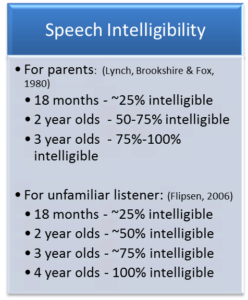In our last post, we introduced you to a case study. The SLP wanted to know if the bilingual 4-year-old would qualify for speech therapy. Many, many questions arise when we are serving our diverse populations, and we appreciate the opportunity to collaborate with you to best provide for our clients and students. Here is the low down on the specifics of the case:
One of the kids that I tested had a qualifying score in Spanish but not in English, we talked about it and you suggested that he should qualify and I should address the sounds that he struggles with in both languages.
In our earlier post, we addressed the errors the child had in both languages (and the specific sounds to address), how his age should be considered when developing goals and considerations for phonology. Now, let’s talk about intelligibility. The real determiner is intelligibility.
Out of 100 words, how many can you understand? These charts come out of an e-book that we are releasing today in case you are interested, Developmental Norms for Speech.
Hope this helps.
Scott
Hello and thank you for all your help! So, basically I would qualify due to intelligibility in dominant language correct? He is about 60% intelligible and is fronting…
Thanks!
How should he qualify for speech therapy?
Yes, intelligibility is a key indicator of qualification because it gets past all of the difficulty between languages. Someone from the child’s environment should be able to understand him or her, regardless of processes or errors present. See the chart above for age-expected measures of intelligibility.
Secondly, yes, fronting should be suppressed at this age in both English and Spanish.
 Here are some goals from our Goal Bank that would apply to this student:
Here are some goals from our Goal Bank that would apply to this student:
Will be 80% intelligible at the word/phrase/sentence level.
Será del 80% inteligible al nivel de la palabra/frase/oracion.
Will reduce the process of fronting by producing velar sounds (i.e., /k, g/) in words at the [word/phrase/sentence] level in 7/10 opportunities with minimal/moderate/maximal cues.
Disminuirá el proceso de frontalización al producir los sonidos velares (ej. /k,g/) en palabras al nivel de [palabra/frase/oración] en 7/10 de las oportunidades con ayuda mínima/mediana/maxima.
Best Regards,
Scott
More Resources:
ASHA – Eligibility and Dismissal in Schools
Region 13 | TSHA Speech Impairment Eligibility Guidelines (Texas)



 Here are some goals from our
Here are some goals from our 
Well, this was fun, like a game to see if I could come up with what should be done. It was great to show the steps (and visual supports you’ve provided us) to figure this out. A language one would be helpful too; perhaps a language one that is a language other than Spanish where we may not have any formal tests. I second guess myself so much.
Gina, I’m glad you enjoyed the post. A language example sounds like a great future post. Thank you, always, for the feedback.
I’m bothered by this scenario because in my district the practice (per instructions from our executive director) is that we would only ask for a Spanish evaluation if the child’s English scores were low enough to qualify him. So, in the situation where the English scores appear to be okay, we would not be asking for Spanish testing. Without the Spanish testing, even with poor intelligibility, the data would likely lead me to attribute the intelligibility issues to negative language transfer issues. So, is this the data I need to suggest to our executive director (and the bilingual evaluator) that if the student is ELL, then we need a bilingual evaluation??
Hi Tracy, Thank you for your comments.
The interpretation of results varies a bit between speech testing and language testing. When we are evaluating language, and we find that one language falls within normal limits and the other does not (using formal and informal measures), we usually consider the language that does not fall within normal limits to be developing, and we call it a language difference. That said, it is best practice to test in both languages to get a full picture of the child’s language abilities and to be able to confidently address the concerns that moved the student to an evaluation. In the area of speech production, it is possible to demonstrate an impairment in one language but not the other if the impairment affects a sound or set of sounds that exists in one language but not the other. So, yes, it is important to test in both languages to have a full understanding of a bilingual student’s speech patterns.
Thanks for reading our blog and good luck!